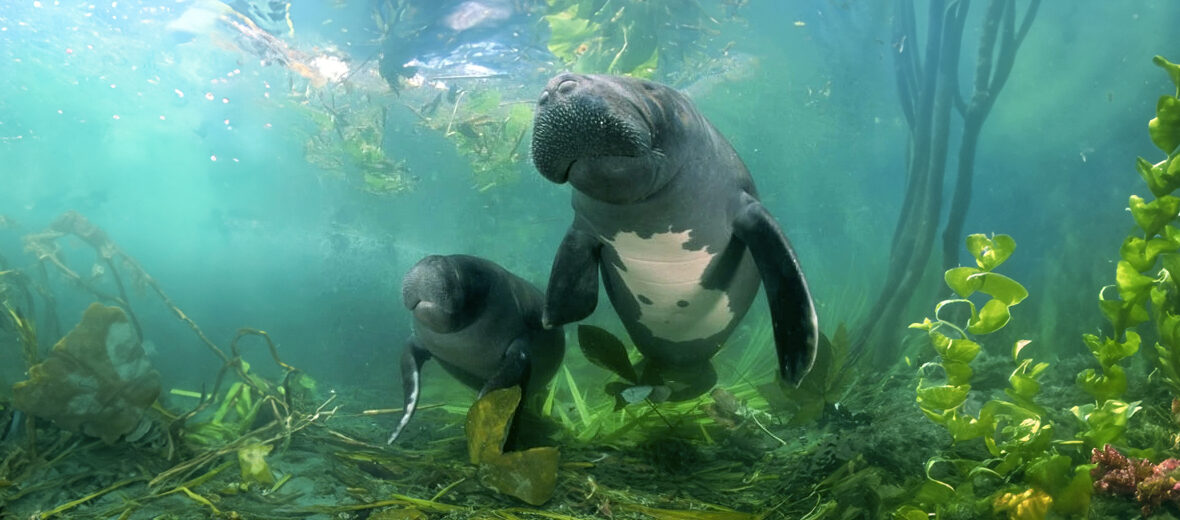
The Amazonian manatee can be found in the rivers of Brazil, Colombia, Ecuador, and Peru. They are the smallest of the 3 manatee species. Sadly, these manatees face numerous threats such as habitat loss and destruction at the hands of residential and commercial development, farming, ranching, logging, freshwater & marine aquaculture, dams, and water management practices; oil and gas drilling; mining; quarrying; shipping lanes that result in vessel strike (being struck by aquatic vessels); recreational activities; hunting; water pollution; and climate change, that can cause temperature extremes, droughts, and habitat alteration. The IUCN lists these beautiful creatures as Vulnerable.
First the Stats…
Scientific name: Trichechus inunguis
Weight: Up to 836 lbs.
Length: Up to 8.9 feet
Lifespan: Up to 30 years
Now on to the Facts!
1.) In 2016 there were just an estimated 13,000 remaining, but those numbers have been steadily decreasing.
2.) Their specific name, inunguis is Latin and translates to “nailless”. The genus name Trichechus, also hails from Latin and translates to “hair”. This is in reference to the whiskers around their mouth.
3.) They are capable of moving each side of their lips independently while feeding.
4.) Unique among mammals, they have polyphyodont teeth. This means that their teeth are continuously replaced horizontally from the caudal (rear) portion of the jaw to the rostral (front) portion, throughout their life.
5.) Only elephants have a similar dental trait, however, elephants have a limited number of reserve teeth; whereas manatees continually grow teeth the entirety of their life.
But wait, there’s more on the Amazonian manatee!
6.) As their teeth migrate forward in these manatees, the roots are resorbed and the thin enamel wears down until the tooth is eventually lost.
7.) Amazonian manatees don’t have nails on their flippers, which is different from other manatees.
Did you know…?
These critters are the only sirenian that lives exclusively in freshwater. The other 2 species can also exist in salt and brackish water habitats.
8.) The subtle degree of rostral (nasal) deflection allows these manatees to feed more efficiently at the surface of the water, seeing as this is where most of their food is located.
9.) The Amazonian and West Indian manatees are the only manatees that vocalize. These vocalizations are meant to communicate between the cows and their calves. However, they also vocalize while alone and with others.
10.) They depend on changes in the peripheral circulation (blood flow outside of the heart and central nervous system) for their primary means of thermoregulation by using sphincters (a type of muscles) to deflect blood flow from areas of the body closest to the water. They also rely on subcutaneous (internal) fat to reduce heat loss.
But wait, there’s still more on the Amazonian manatee!
11.) Manatees have nostrils instead of blowholes like other 100% aquatic mammals, that close while submerging to keep water out and then open when above water to breathe.
12.) While they aren’t necessarily migratory, they do perform seasonal movements that are synchronized with the flooding of the Amazon Basin. They are usually found in flooded forests and meadows during the flood season, when food is more plentiful.
Did you know…?
The longest submerging event recorded was approximately 14 minutes, while the normal time spent underwater is just 5 minutes.
13.) These critters are cathemeral (active both day and night).
14.) Like all manatees, they spend their entire lives underwater, only protruding their snout for oxygen exchange.
15.) Water lettuce, bladderworts, various grasses, hornworts, water lilies, water hyacinths, and palm fruits that fall into the water are all on the menu.
But wait, there’s still a bit more more on the Amazonian manatee!
16.) Their digestive system is similar to that of a horse.
17.) During the 2+ month long dry season when water levels start to fall, some individuals become stranded in the deep parts of larger lakes, where they often stay till the end of the dry season in March. They are thought to fast during this time, relying on their fat reserves and low metabolic rates (only 36% of the usual placental mammal metabolic rate) allowing them to survive for up to 7 months with little to no food.
Did you know…?
They eat up to 8% of their body weight each day.
18.) Females undergo up to a 14 month gestation (pregnancy) that yields a single calf.
19.) Amazonian manatee calves grow at a rate of up to 2.2 lbs. per week and up to .08 inch a day.
20.) Weaning takes place in up to 18 months.
But wait, there’s still a tad more more on the Amazonian manatee!
21.) Between 1935 – 1954, over 140,000 manatees were estimated to have been killed. Even though there were laws in place against this.
22.) Hunting continues to occur even in protected areas. Traditional harpoons are the most common weapon used to obtain these gentle creatures, but in Ecuador they are also known to be caught in Arapaima fish traps.
23.) They are primarily hunted for their highly prized meat, but the fat and skin are also used for cooking and in traditional medicines. The meat is sold locally to neighbors or at produce markets. It’s also sold illegally as sausage or mixira (meat preserved in its own fat) in public markets in Brazil and Ecuador. Mixira is expensive which is why they are prized by hunters.
24.) There aren’t any national management plans for the Amazonian Manatee, sans in Colombia. As of 2008, the INPA takes care of 34 captive manatees and the CPPMA is caring for 31 manatees. The manatee has been protected by Peruvian law since 1973, via Supreme Decree 934-73-AG, strictly prohibiting hunting and commercial use of these creatures. Although, as mentioned, the laws aren’t exactly adhered to.
Now a Short Amazonian Manatee Video!
Be sure to share & comment below! Also, check out the Critter Science YouTube channel. Videos added regularly!
Want to suggest a critter for me to write about? Let me know here.
Some source material acquired from: Wikipedia & IUCN
Photo credit: Animal Library Fandom




